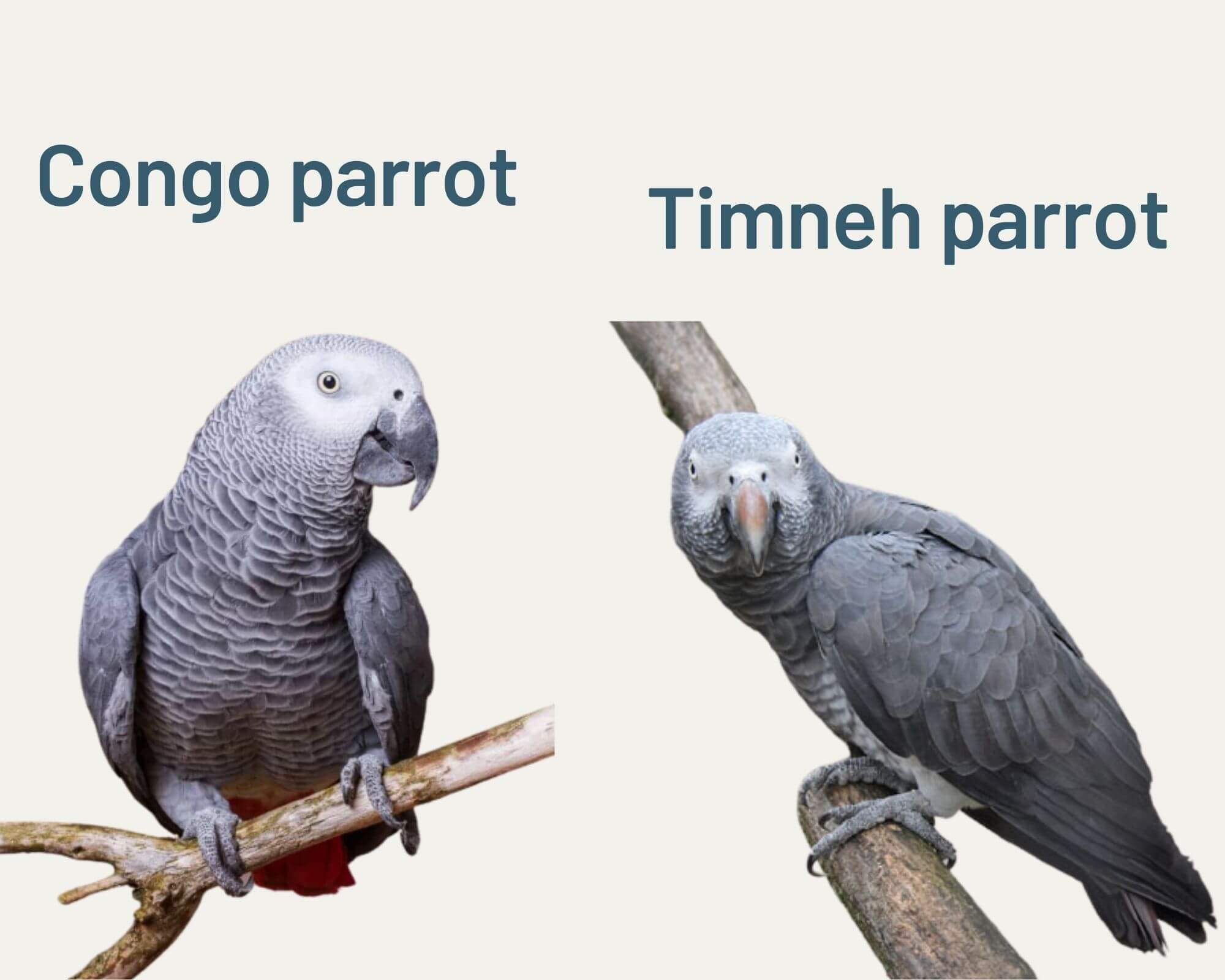A large charismatic parrot of equatorial Africa with unique gray plumage and a conspicuous reddish tail. the parrot african grey is highly threatened by both forest loss and capture for the international wildlife trade and has experienced precipitous population declines in many regions.

Among its 3 subspecies, P. e. timneh of West Africa is smaller, has darker plumage and a maroon tail, and is considered a separate species by some authorities. P. e. Erithacus is paler gray with a red tail and primarily occurs in Central Africa, whereas P. e. Princeps occurs only on Principe in the Gulf of Guinea.
The Parrot african grey favors humid forests, including edges and clearings, and is strongly associated with oil-palm plantation—the species can be quite common in areas where it is well protected.
Identification
Large stocky parrot (length 28–39 cm) with unique gray plumage and white patch around eye; in flight, shows a conspicuous red tail (subspecies Erithacus and princeps) or maroon tail (subspecies timneh), and a pale rump.
Similar Species
Unlikely to be confused with any other Parrot.
Plumages
Immature
Similar to adult, but has dark red tail tips and under the tail, coverts are tinged gray.
Adult
Gray head scaled with white, and white patch around the eye; gray back, breast, and wing coverts, with blackish gray primaries; tail and tail coverts bright red (dark maroon in subspecies timneh).
Sexes alike, but males become darker with age than females, and older birds can attain some (occasionally many) scarlet feathers in the belly and thighs; albinos have also been reported. Size, notably that of the bill, is individually variable independent of age.
Molts
There is no specific study of molt in wild Parrot african grey; however, there is evidence the parrots may molt both primaries and secondaries bidirectionally, from the medial node, the location where molt begins. In the majority of parrots, primary feather molt starts at p5 or p6, and secondary molt starts at s5.
Bare Parts
Bill
Gray to blackish innominate; similar in P. e. timneh, but with the pinkish-gray upper half of upper mandible.
Iris and Facial Skin
Iris is yellow in adults and gray in immature. The bare facial area around the eye is whitish.
Legs and Feet
Dark gray to blackish.
Measurements
Linear Measurements
Although based on small sample sizes, subspecies Erithacus is larger overall than timneh, and more similar in size to princeps.
P. e. Princeps, data from Melo and O’Ryan.
| n | Mean (mm) | |
| Wing length | 9 | 247.7 |
| Tail length | 13 | 93.7 |
| Tarsus length | 15 | 24.8 |
| Bill length | 15 | 35.2 |
P. e. timneh, data from Forshaw, n = 7.
| Range (mm) | |
| Wing length | 203—225 |
| Tail length | 74—84 |
| Tarsus length | 22—26 |
| Bill length | 29—33 |
P. e. Erithacus, data from Melo and O’Ryan.
| n | Mean (mm) | |
| Wing length | 11 | 251.6 |
| Tail length | 12 | 102.3 |
| Tarsus length | 16 | 27.1 |
| Bill length | 16 | 34.2 |
Mass
P. e. Erithacus, 402–490 g.
Systematics History
Subspecies P. e. timneh has been considered a separate species by some authorities (e.g).
Geographic Variation
In a recent study investigating genetic differences among the subspecies of Parrot african grey, Melo and O’Ryan found strong genetic differentiation between P. e. Erithacus and P. e. timneh, estimating that these subspecies diverged up to 2.4 million years before the present. Based only on mitochondrial DNA, there appears to be little to no gene flow between P. e. Erithacus and P. e. timneh.
Surprisingly, birds from Principe Island were found to belong to two genetic lineages, one corresponding to the named P. e. Princeps subspecies, which appeared to be most closely related to P. e. timneh, from which it may have split between up to 1.4 million years before present, and another that was found to be embedded within nominate P. e. Erithacus.
Melo and O’Ryan suggested that the first lineage diverged on Principe after initial colonization from the mainland, while the second lineage represents second colonization from the mainland of nominate P. e. Erithacus.
This second colonization could be the result of the human introduction of nominating P. e. Erithacus. More research is needed to fully understand the history of this group.
Subspecies
Three subspecies were recognized. With respect to plumage and morphometrics, P. e. Princeps are often considered inseparable from nominate, but this subspecies is genetically different from mainland populations.
Parrot African grey (Timneh)Psittacus erithacus timneh/princeps

Psittacus erithacus timneh Scientific name definitions
Systematics History
P. e. timneh Fraser, 1844 [type locality = Timneh country, Sierra Leone]. Subspecies have been considered separate species by some authorities (e.g).
Distribution
Southern Guinea to Ivory Coast (west of Comoé River); isolated populations in Guinea-Bissau and southern Mali.
Identification
Smaller than nominate, with darker plumage and maroon tail (not red), pinkish-gray (not blackish) upper half of upper mandible; slightly protracted central tail tip.
SOURCE: Uncharted Wild
Psittacus erithacus princeps Scientific name definitions
Systematics History
P. e. princeps Alexander, 1909 [type locality = Principe Island, Gulf of Guinea].
Distribution
Principe Island in the Gulf of Guinea.
Identification
No known plumage differences from nominate.
Parrot african grey(Gray)Psittacus erithacus erithacus Scientific name definitions

Systematics History
P. e. Erithacus Linnaeus, 1758 [type locality = Ghana].
Distribution
Ivory Coast (east of Comoé River) east to western Kenya and northwestern Tanzania and south to the south-central Democratic Republic of the Congo and northern Angola (Cabinda), including Bioko; probably introduced on Sao Tome in the Gulf of Guinea.
Identification
Larger than subspecies timneh, with paler gray plumage and red tail (not dark maroon); upper half of upper mandible blackish (not pinkish-gray). Additional details under Plumage.
Related Species
Parrot African grey is the only member of the genus Psittacus. Based on all recent phylogenetic studies using DNA sequence data, the Gray Parrot appears to be a sister to the parrots in the genus Poicephalus, and also endemic to Africa.
SOURCE: Animal Fact Files
In one study, Gray Parrot was actually found to be embedded within Poicephalus, however, the authors speculated that the result may be due to biases from sampling a different number of loci. These two genera appear to be sisters to all of the New World parrots.




















